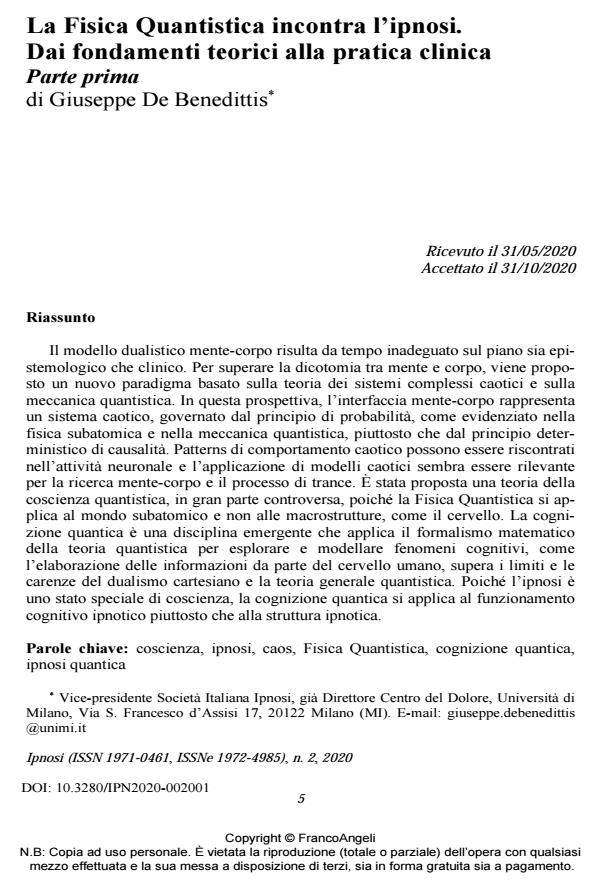La Fisica Quantistica incontra l’ipnosi. Dai fondamenti teorici alla pratica clinica Parte prima
Titolo Rivista IPNOSI
Autori/Curatori Giuseppe De Benedittis
Anno di pubblicazione 2020 Fascicolo 2020/2
Lingua Italiano Numero pagine 19 P. 5-23 Dimensione file 240 KB
DOI 10.3280/IPN2020-002001
Il DOI è il codice a barre della proprietà intellettuale: per saperne di più
clicca qui
Qui sotto puoi vedere in anteprima la prima pagina di questo articolo.
Se questo articolo ti interessa, lo puoi acquistare (e scaricare in formato pdf) seguendo le facili indicazioni per acquistare il download credit. Acquista Download Credits per scaricare questo Articolo in formato PDF

FrancoAngeli è membro della Publishers International Linking Association, Inc (PILA)associazione indipendente e non profit per facilitare (attraverso i servizi tecnologici implementati da CrossRef.org) l’accesso degli studiosi ai contenuti digitali nelle pubblicazioni professionali e scientifiche
Il modello dualistico mente-corpo risulta da tempo inadeguato sul piano sia epistemologico che clinico. Per superare la dicotomia tra mente e corpo, viene proposto un nuovo paradigma basato sulla teoria dei sistemi complessi caotici e sulla meccanica quantistica. In questa prospettiva, l’interfaccia mente-corpo rappresenta un sistema caotico, governato dal principio di probabilità, come evidenziato nella fisica subatomica e nella meccanica quantistica, piuttosto che dal principio de-terministico di causalità. Patterns di comportamento caotico possono essere riscontrati nell’attività neuronale e l’applicazione di modelli caotici sembra essere rilevante per la ricerca mente-corpo e il processo di trance. È stata proposta una teoria della coscienza quantistica, in gran parte controversa, poiché la Fisica Quan-tistica si applica al mondo subatomico e non alle macrostrutture, come il cervello. La cognizione quantica è una disciplina emergente che applica il formalismo matematico della teoria quantistica per esplorare e modellare fenomeni cognitivi, come l’elaborazione delle informazioni da parte del cervello umano, supera i limiti e le carenze del dualismo cartesiano e la teoria generale quantistica. Poiché l’ipnosi è uno stato speciale di coscienza, la cognizione quantica si applica al funzionamento cognitivo ipnotico piuttosto che alla struttura ipnotica.
Parole chiave:Coscienza, ipnosi, caos, Fisica Quantistica, cognizione quantica, ipnosi quantica
- I fenomeni ipnotici nel trattamento del disturbo sessuale della penetrazione Ilaria Genovesi, Luca Bidogia, Carlotta Di Giusto, in IPNOSI 1/2025 pp.49
DOI: 10.3280/IPN2025-001004
Giuseppe De Benedittis, La Fisica Quantistica incontra l’ipnosi. Dai fondamenti teorici alla pratica clinica Parte prima in "IPNOSI" 2/2020, pp 5-23, DOI: 10.3280/IPN2020-002001